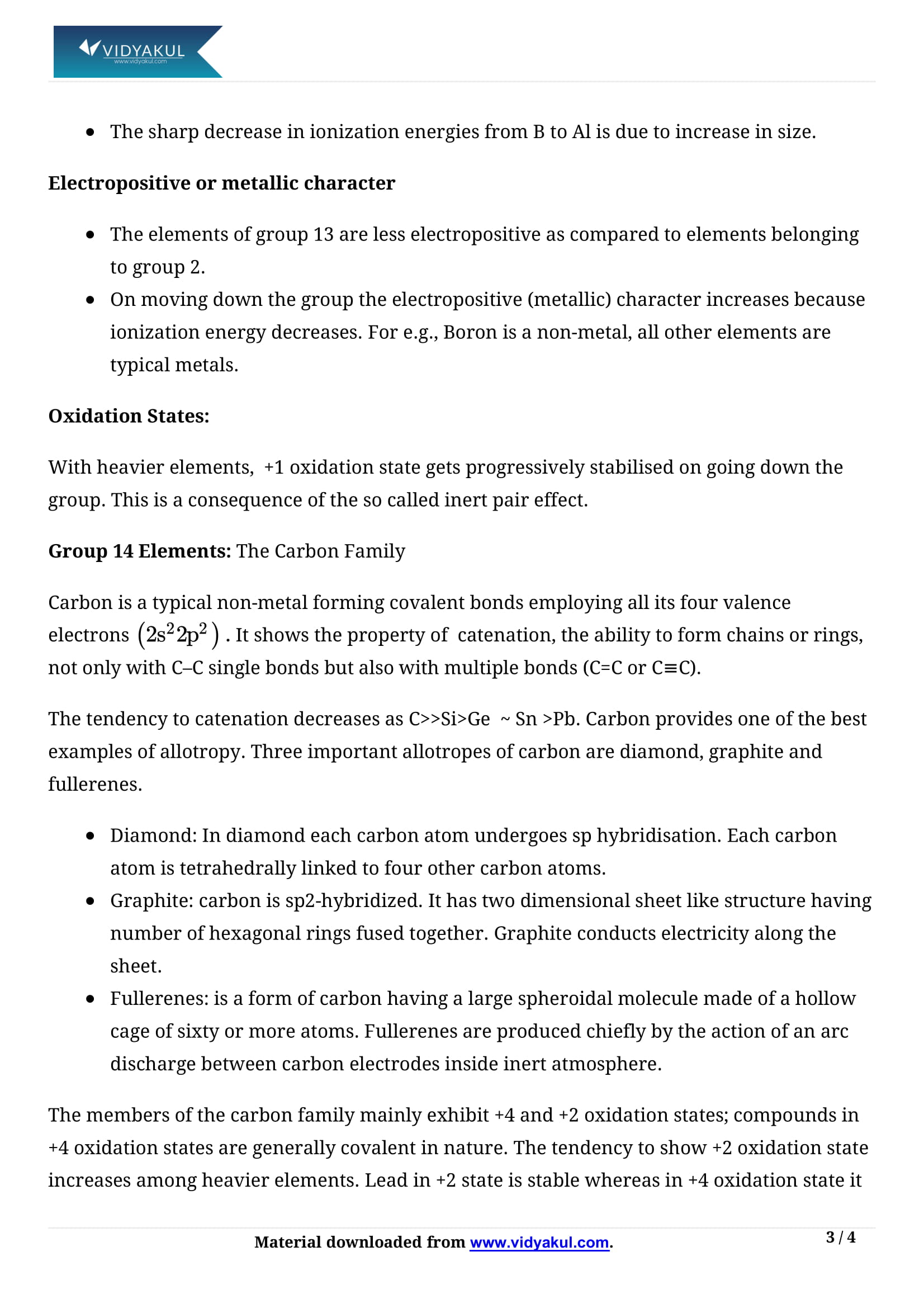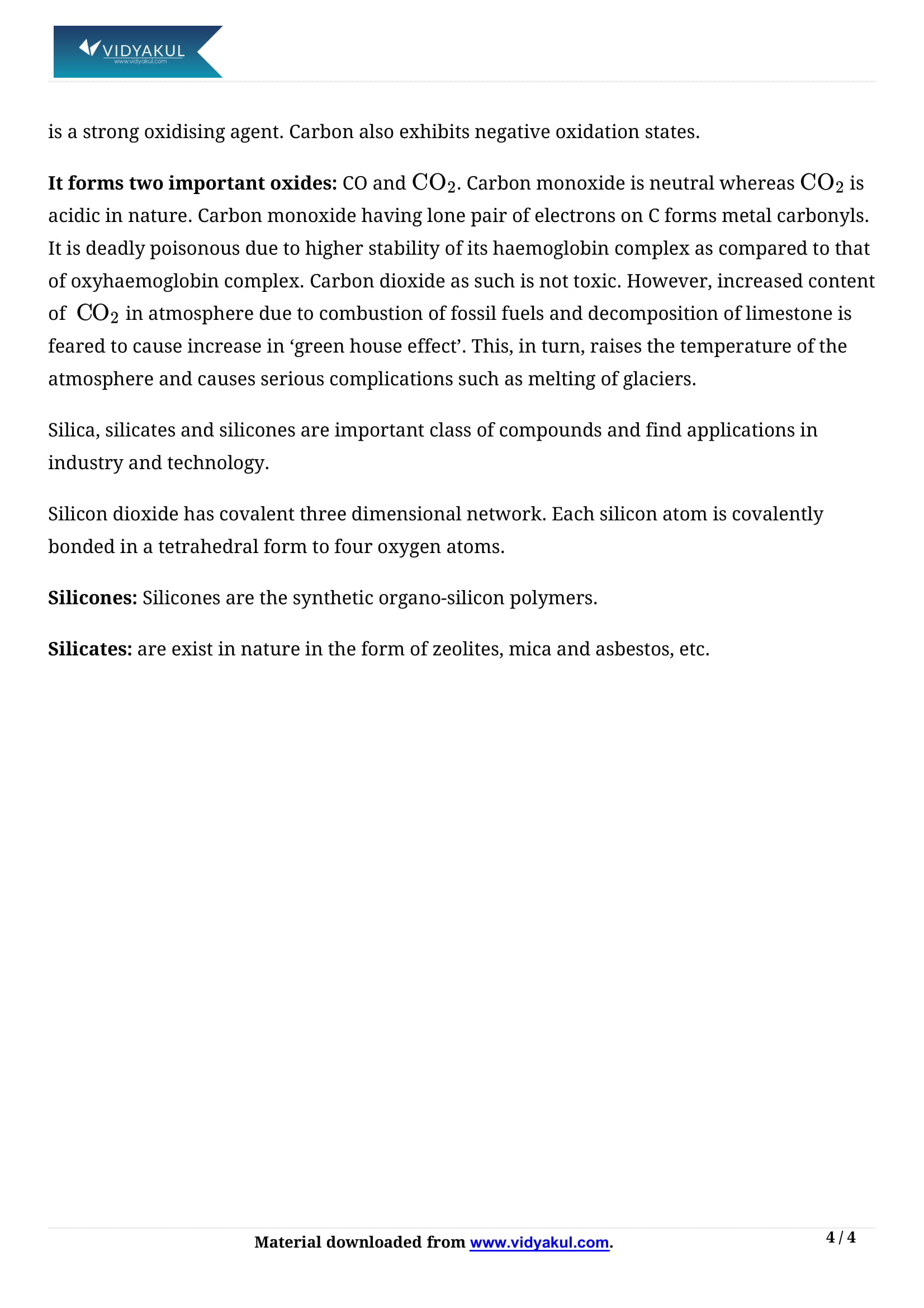The p-Block Elements Class 11 Notes

Chapter 11 The p-Block Elements
There are six groups of p-elements in the periodic table from 13 to 18 with electronic configurations ns2np1-6. There are all types of elements such as metalloids, non-metals and metals. Their chemical and physical properties are greatly influenced by the difference in the electronic configuration of the inner core. The lighter elements of the group have fairly stable group oxidation states. Heavier elements form dπ–dπ or dπ–pπ bonds and have lower oxidation states that are more stable. Lighter elements form pπ–pπ bonds. If an element in the second period does not have a d-orbital, the maximum share is limited to 4, whereas heavier ones can exceed this limit.
CBSE 11th CHEMISTRY CH-11
Points to Remember
Group Members-boron (B), gallium (Ga), indium (In), aluminium (Al) & thallium (Tl).
Example of a typical non-metal is Boron and the other members are metals.
An example of a typical non-metal is boron. A fairly rare element, Boron mainly occurs as orthoboric acid, (H3BO3), borax, Na2B4O7·10H2O, and kernite, Na2B4O7·4H2O.
Covalent bond formation by using four orbitals (2px, 2s, 2py, 2pz) with the convenience of 3 valence electrons 2s22p1 leads to the electron deficiency in boron compounds.
Due to this deficiency, they are a good electron acceptor and therefore behave as Lewis acids. Boranes are formed when boron and dihydrogen form a covalent molecular compound.
One simple example is diborane which contains 2 bridging hydrogen atoms between 2 boron atoms.
Some examples of compounds of boron-containing dioxygen are borax and boric acid.
Boric acid – a weak monobasic acid that acts as Lewis acid by accepting electrons from hydroxyl ion.
Borax – a white crystalline solid. The borax bead test gives characteristic colours of transition metals.
Topics and Sub-topics
The topics and sub-topics in NCERT notes for 11th Chemistry Chapter 11 are as below:
Frequently Asked Questions
How can ‘p-Block’ elements be defined?
P block elements are those in which the last electron enters any of the three p-orbitals of their respective shells.
What are some of the properties of ‘Boron’?
1. Element Category: Metalloid2. Density: 2.08g/cm33. Melting Point: 3769 F (2076 C)4. Boiling Point: 7101 F (3927 C)
What are some of the uses of ‘Carbon’?
1. 18% of human body is made up of carbon 2. Used in jewellery 3. Used in the manufacture of paints, inks
Practice Questions
Explain why boron trifluoride behaves like a Lewis acid.
Excessive content of CO2 is responsible for global warming. How?
Justify the amphoteric nature of aluminium by writing the reactions.
Why do white fumes appear around the bottle of anhydrous aluminium chloride? State a reason.
Explain why Boron is unable to form BF63– ion?
Diamond is covalent, yet it has a high melting point. Why?
What are silicones ?
Group Members-boron (B), gallium (Ga), indium (In), aluminium (Al) & thallium (Tl).
Example of a typical non-metal is Boron and the other members are metals.
An example of a typical non-metal is boron. A fairly rare element, Boron mainly occurs as orthoboric acid, (H3BO3), borax, Na2B4O7·10H2O, and kernite, Na2B4O7·4H2O.
Covalent bond formation by using four orbitals (2px, 2s, 2py, 2pz) with the convenience of 3 valence electrons 2s22p1 leads to the electron deficiency in boron compounds.
Due to this deficiency, they are a good electron acceptor and therefore behave as Lewis acids. Boranes are formed when boron and dihydrogen form a covalent molecular compound.
One simple example is diborane which contains 2 bridging hydrogen atoms between 2 boron atoms.
Boric acid – a weak monobasic acid that acts as Lewis acid by accepting electrons from hydroxyl ion.
Borax – a white crystalline solid. The borax bead test gives characteristic colours of transition metals.
How can ‘p-Block’ elements be defined?
What are some of the properties of ‘Boron’?
What are some of the uses of ‘Carbon’?
Explain why boron trifluoride behaves like a Lewis acid.
Excessive content of CO2 is responsible for global warming. How?
Justify the amphoteric nature of aluminium by writing the reactions.
Why do white fumes appear around the bottle of anhydrous aluminium chloride? State a reason.
Explain why Boron is unable to form BF63– ion?
Diamond is covalent, yet it has a high melting point. Why?
What are silicones ?
Learn More about the same in The p-Block Elements Class 11 Notes PDF.
Download this solution for FREE Download this PDF







